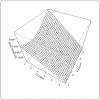Exploring associations between prenatal exposure to multiple endocrine disruptors and birth weight with exposure continuum mapping
- PMID: 34087191
- PMCID: PMC8403640
- DOI: 10.1016/j.envres.2021.111386
Exploring associations between prenatal exposure to multiple endocrine disruptors and birth weight with exposure continuum mapping
Abstract
Background: Improved understanding of how prenatal exposure to environmental mixtures influences birth weight or other adverse outcomes is essential in protecting child health.
Objective: We illustrate a novel exposure continuum mapping (ECM) framework that combines the self-organizing map (SOM) algorithm with generalized additive modeling (GAM) in order to integrate spatially-correlated learning into the study mixtures of environmental chemicals. We demonstrate our method using biomarker data on chemical mixtures collected from a diverse mother-child cohort.
Methods: We obtained biomarker concentrations for 16 prevalent endocrine disrupting chemicals (EDCs) collected in the first-trimester from a large, ethnically/racially diverse cohort of healthy pregnant women (n = 604) during 2009-2012. This included 4 organochlorine pesticides (OCPs), 4 polybrominated diphenyl ethers (PBDEs), 4 polychlorinated biphenyls (PCBs), and 4 perfluoroalkyl substances (PFAS). We applied a two-stage exposure continuum mapping (ECM) approach to investigate the combined impact of the EDCs on birth weight. First, we analyzed our EDC data with SOM in order to reduce the dimensionality of our exposure matrix into a two-dimensional grid (i.e., map) where nodes depict the types of EDC mixture profiles observed within our data. We define this map as the 'exposure continuum map', as the gridded surface reflects a continuous sequence of exposure profiles where adjacent nodes are composed of similar mixtures and profiles at more distal nodes are more distinct. Lastly, we used GAM to estimate a joint-dose response based on the coordinates of our ECM in order to capture the relationship between participant location on the ECM and infant birth weight after adjusting for maternal age, race/ethnicity, pre-pregnancy body mass index (BMI), education, serum cotinine, total plasma lipids, and infant sex. Single chemical regression models were applied to facilitate comparison.
Results: We found that an ECM with 36 mixture profiles retained 70% of the total variation in the exposure data. Frequency analysis showed that the most common profiles included relatively low concentrations for most EDCs (~10%) and that profiles with relatively higher concentrations (for single or multiple EDCs) tended to be rarer (~1%) but more distinct. Estimation of a joint-dose response function revealed that lower birth weights mapped to locations where profile compositions were dominated by relatively high PBDEs and select OCPs. Higher birth weights mapped to locations where profiles consisted of higher PCBs. These findings agreed well with results from single chemical models.
Conclusions: Findings from our study revealed a wide range of prenatal exposure scenarios and found that combinations exhibiting higher levels of PBDEs were associated with lower birth weight and combinations with higher levels of PCBs and PFAS were associated with increased birth weight. Our ECM approach provides a promising framework for supporting studies of other exposure mixtures.
Keywords: Endocrine disrupting chemicals; Environmental exposures; Fetal growth; Kohonen; Mixtures; Pregnancy.
Copyright © 2021 Elsevier Inc. All rights reserved.
Conflict of interest statement
Declaration of Competing Interest
The authors declare that they have no known competing financial interests or personal relationships that could have appeared to influence the work reported in this paper.
Figures




References
-
- Bergman A, Heindel JJ, Kasten T, Kidd KA, Jobling S, Neira M, Zoeller RT, Becher G, Bjerregaard P, Bomman R, Brandt I, Kortenkamp A, Muir D, Drisse MN, Ochieng R, Skakkebaek NE, Bylehn AS, Iguchi T, Toppari J, Woodruff TJ. The impact of endocrine disruption: a consensus statement on the state of the science. Environ Health Perspect. 2013;121(4):A104–6. Epub 2013/04/04. doi: 10.1289/ehp.1205448. - DOI - PMC - PubMed
-
- Flaws JD P; Patisaul HB; Gore A; Ratzman L; Vandenberg LN Plastics, EDCs & Health. www.endocrine.org: 2020 12/01/2020. Report No.
Publication types
MeSH terms
Substances
Grants and funding
LinkOut - more resources
Full Text Sources

